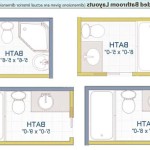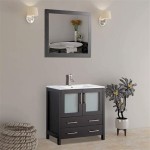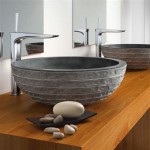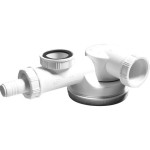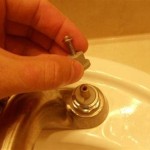Are Bathroom Exhaust Fans Standard Size? Understanding Dimensions and Installation
Bathroom exhaust fans play a crucial role in maintaining healthy indoor air quality by removing moisture, odors, and pollutants. When upgrading, replacing, or installing a new bathroom fan, understanding the typical sizes and dimensions is essential for a successful project. While there isn't a single, universally adopted "standard" size, bathroom exhaust fans generally adhere to a limited range of dimensions that correlate with the room's size and ventilation needs.
The idea of a "standard size" can be misleading because it encompasses multiple aspects: the fan's housing dimensions, the duct size, and the cubic feet per minute (CFM) rating. These factors are interdependent, and understanding their relationship helps in selecting the appropriate fan for a given bathroom.
The primary consideration is the airflow, measured in CFM, needed to effectively ventilate the bathroom. This is directly related to the room's square footage and usage frequency. Larger bathrooms and those with features like whirlpool tubs or frequently used showers require higher CFM ratings. Consequently, fans with higher CFM ratings often have larger physical dimensions.
The purpose of this article is to provide a comprehensive overview of bathroom exhaust fan sizes, focusing on the key dimensions and factors that influence selection. This information is intended to guide homeowners and contractors in choosing the right fan for their specific needs, ensuring optimal ventilation and long-term performance.
Key Point 1: Common Bathroom Exhaust Fan Dimensions
While no strict "standard size" exists, bathroom exhaust fans generally fall within a defined range of dimensions. The dimensions usually refer to the size of the fan housing, which is the part that sits flush against the ceiling. Common dimensions for the housing are 8"x8", 9"x9", 10 1/2"x10 1/2", and 11 3/8"x11 3/8". These dimensions affect installation, as the rough opening in the ceiling must accommodate the housing.
Many older homes have smaller bathroom exhaust fans, typically around 7.5" x 7.5" or 8" x 8". These legacy sizes can present challenges when upgrading, as finding a direct replacement with the same dimensions might be difficult. Adapting the ceiling opening may be necessary to accommodate a larger, more modern fan.
The thickness of the fan housing, which affects how much the fan protrudes from the ceiling, is another important dimension to consider. Thicker housings might be necessary for fans with more advanced features, such as integrated lights or humidity sensors. However, a thicker housing might not be suitable for bathrooms with low ceilings.
Duct size is also a critical dimension. Common duct sizes for bathroom exhaust fans are 3", 4", and 6". The duct connects the fan to the outside vent, allowing moist air to be expelled. The appropriate duct size depends on the fan's CFM rating and the length of the duct run. Longer duct runs and higher CFM ratings typically require larger diameter ducts to minimize static pressure and ensure efficient airflow.
For instance, a fan with a CFM rating of 50 might use a 3" or 4" duct, while a fan with a CFM rating of 100 or higher might require a 6" duct. Using an undersized duct can significantly reduce the fan's performance and increase noise levels. It is crucial to consult the fan manufacturer's specifications for the recommended duct size.
The location of the duct connection on the fan housing is also a factor. Some fans have side-mounted duct connections, while others have top-mounted connections. The choice depends on the available space in the ceiling and the existing ductwork configuration. Side-mounted connections are often easier to work with in tight spaces.
When replacing an existing fan, measuring the dimensions of the old fan's housing and duct connection is a crucial first step. This helps in identifying a suitable replacement that fits within the existing space and connects to the existing ductwork. If a direct replacement is not available, modifications to the ceiling or ductwork might be necessary.
Key Point 2: Understanding CFM Ratings and Bathroom Size
The Cubic Feet per Minute (CFM) rating is the most important factor to consider when selecting a bathroom exhaust fan. CFM measures the volume of air the fan can move per minute. The required CFM rating depends on the size of the bathroom and its intended use. A higher CFM rating is necessary for larger bathrooms and those with features that generate more moisture.
The Home Ventilating Institute (HVI) recommends a minimum CFM rating based on the bathroom's square footage. The general rule of thumb is to have at least 1 CFM per square foot. For example, a bathroom that is 50 square feet should have a fan with a CFM rating of at least 50. This ensures adequate ventilation to remove moisture and prevent mold growth.
Bathrooms with features like whirlpool tubs, steam showers, or enclosed toilet areas require higher CFM ratings. For whirlpool tubs, an additional 50 CFM is often recommended. Steam showers may require even higher CFM ratings, depending on the size and usage frequency. Enclosed toilet areas benefit from dedicated ventilation to remove odors and pollutants. A fan with a CFM rating of 80-110 is often suitable for this specific area.
In addition to the square footage and features, the height of the ceiling also affects the required CFM rating. Bathrooms with higher ceilings have a larger air volume, requiring a higher CFM to ensure effective ventilation. A formula that incorporates ceiling height may be needed to determine the precise CFM requirements for unusually tall bathrooms.
It's generally better to err on the side of a slightly higher CFM rating than a lower one. An undersized fan may not adequately remove moisture and odors, leading to mold growth and poor air quality. An oversized fan, on the other hand, can be slightly noisier and consume more energy, but it will provide better ventilation.
Many modern bathroom exhaust fans come with adjustable CFM settings. This allows the user to customize the fan's performance based on their needs and preferences. Adjustable CFM fans can be particularly useful in bathrooms with variable usage patterns.
When selecting a fan, it is crucial to consider the noise level, which is measured in sones. Lower sone ratings indicate quieter fans. A fan with a sone rating of 1.0 or less is considered very quiet and suitable for most bathrooms. Fans with higher sone ratings may be more noticeable and potentially disruptive.
The combination of appropriate CFM rating and low sone rating is essential for a comfortable and effective bathroom ventilation system. It's important to balance ventilation performance with noise level to ensure a pleasant user experience.
Key Point 3: Installation Considerations and Adapting to Existing Spaces
Installing a bathroom exhaust fan requires careful planning and attention to detail. The installation process can vary depending on whether it's a new installation or a replacement of an existing fan. In either case, ensuring proper wiring, ductwork, and sealing are crucial for optimal performance and safety.
When replacing an existing fan, the first step is to turn off the power to the circuit. Then, remove the old fan and assess the condition of the existing ductwork and wiring. If the ductwork is damaged or undersized, it should be replaced to ensure proper airflow. The wiring should be inspected for any signs of damage or deterioration.
If the replacement fan has different dimensions than the old one, modifications to the ceiling opening may be necessary. This may involve cutting or patching the drywall to create a proper fit. It's important to use appropriate tools and techniques to ensure a clean and professional finish.
Connecting the ductwork to the fan is a critical step. The duct should be securely attached to the fan using clamps or foil tape. Any gaps or leaks in the ductwork can reduce the fan's performance and increase noise levels. It's also important to ensure that the duct is properly insulated to prevent condensation.
The electrical wiring should be connected according to the manufacturer's instructions. Incorrect wiring can damage the fan or create a safety hazard. If you are not comfortable working with electrical wiring, it's best to hire a qualified electrician.
When installing a new bathroom exhaust fan in a bathroom that doesn't already have one, the process is more involved. It requires running new ductwork to an exterior wall or roof and installing new electrical wiring. This type of installation may require professional assistance.
The location of the exhaust vent on the exterior wall or roof should be carefully chosen to ensure that the moist air is directed away from the house. The vent should be positioned so that it is not obstructed by trees, bushes, or other obstacles. A properly installed vent will prevent moisture from re-entering the house and causing damage.
Sealing the fan housing to the ceiling is essential to prevent air leaks. Use caulk or foam sealant to seal any gaps between the housing and the ceiling. This will improve the fan's performance and reduce energy loss. It also prevents drafts and helps to maintain a consistent temperature in the bathroom.
After installation, test the fan to ensure that it is working properly. Check the airflow and listen for any unusual noises. Verify that the fan is exhausting air to the outside and that there are no leaks in the ductwork. A properly installed bathroom exhaust fan will provide years of reliable service and help to maintain a healthy indoor environment.

5 Ways To Calculate Cfm For Bathroom Fan Wikihow

Standard 125mm Duct Size White Ventilation Fan Bathroom Air Flow Kitchen Extractor

What Extractor Fan Do I Need For My Bathroom Blog World

Exhaust Fan Standard Wall 11 13 15 Inches Plastic Square Louver

How To Choose The Best Bathroom Fan Size For Your Space Bob Vila

4 5 6 Inline Extractor Fan Timer Standard Full 1m Kit Ventilation B Fans4less

6 Things To Consider Before Exhaust Fan Kitchen Or Bathroom Crompton

Bathroom Exhaust Fan Guide The Home Depot

6 Things To Consider Before Exhaust Fan Kitchen Or Bathroom Crompton

How To Choose The Best Bathroom Fan Size For Your Space Bob Vila

